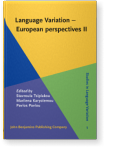Meaning variation and change in Greek morphology
The paper discusses how and why meaning variants can arise in words like sin-érxome, sin-gráfo and sin-taksidhévo: sin-érxome has both an idiosyncratic meaning “recover” and a compositional meaning “come with”, while sin-gráfo only has the idiosyncratic meaning “I author” and sin-taksidhévo only has the compositional reading “I co-travel”. In this paper I confine myself to this kind of morpho-semantic variation within Greek, synchronically and, to a limited extent, diachronically. The spectrum of explanations will range from the Saussurian ‘arbitraire’ to folk etymology, to the dichotomy ‘the lexicon vs. the syntax’, and finally to the minimalist ‘only the syntax is generative’. Under the syntacticallyoriented theory of Distributed Morphology (Marantz 2001 etc.), I show how the place of merger for a given affix may vary between affix+root, giving idiosyncratic interpretations (sin-gráfo), and affix+(categorised) stem, giving compositional interpretations (sin-taksidhévo). The paper concludes with a brief extension to meaning change within the same framework.
Cited by (1)
Cited by one other publication
Koutsoukos, Nikos & Angeliki Efthymiou
2023.
Derivational morphology in Modern Greek.
Journal of Greek Linguistics 23:2
► pp. 215 ff.

This list is based on CrossRef data as of 11 march 2024. Please note that it may not be complete. Sources presented here have been supplied by the respective publishers.
Any errors therein should be reported to them.
